Best Budget Headphone Under $50 | Wired Headset
Introduction
In the ever-evolving world of personal audio, wired headphones continue to be a popular choice for many, and for good reasons. Despite the rise of wireless technology, a well-designed pair of wired headphones under $50 can provide excellent sound quality, reliable performance, and great value. Whether you’re an occasional listener looking to experience richer, more immersive audio or a dedicated enthusiast in need of a dependable option for your daily commute or home setup, this introduction will highlight the key benefits and considerations that make affordable wired headphones a wise investment.
Why Wired Headphones Still Matter
Reliability and Consistency
Wired headphones provide a direct, uncompressed connection between your audio source and your ears. Unlike Bluetooth or other wireless options, there are no pairing hassles, signal dropouts, or worries about battery life. Just plug them in and play—every time you pick up your device, your listening experience is ready and waiting.
Audio Fidelity
Many audiophiles contend that wired connections, particularly those with high-quality drivers and cables, can produce sound with greater fidelity. Even at a price point as low as $50, advancements in driver design, acoustic tuning, and materials—such as Mylar diaphragms and neodymium magnets—allow manufacturers to deliver a balanced and detailed sound signature. This often leads to a performance that surpasses similarly priced wireless options.
Affordability and Accessibility
Wired headphones priced under $50 offer access to high-quality audio without straining your budget. This price range has become highly competitive, prompting manufacturers to innovate and include additional features—such as detachable cables, in-line controls, and interchangeable ear pads—in affordable options. For many users, this represents an ideal balance between cost and performance.
Understanding the Trade-Offs
Build Quality versus Price
At this price point, you might find that some components are made of plastic instead of metal, the headband adjustments are simpler, and the warranty periods are shorter. However, a reliable option in the $50 range can still provide sturdy construction, a tangle-resistant cable, and well-padded ear cups or ear tips. When choosing headphones, look for reinforced hinges, strain relief at the points where the cable enters, and the availability of replaceable parts whenever possible.
Sound Signature and Tuning
Headphones in this category typically feature sound signatures that cater to consumers, often with slightly enhanced bass, clear mids, and bright highs. While this tuning can make music more engaging, some purists might consider the bass overpowering or the treble too sharp. If you prefer a flatter, more reference-style sound, you may need to search for specific models that advertise a neutral tuning.
Comfort and Fit
Wired headphones priced under $50 will focus on comfort, though you might have to make some sacrifices regarding the materials used for the ear cups or the clamping force. Over-ear models typically provide better sound isolation and are more comfortable for extended wear, while on-ear styles are generally lighter and more portable. In-ear monitors (IEMs) offer excellent portability and noise isolation, but it’s important to choose the right ear tips to ensure both comfort and a secure fit.
Why Under $50 Is a Sweet Spot
Market Competition Drives Innovation
With more brands entering the budget headphone market, features that were once exclusive to premium models—such as detachable cables, memory foam ear pads, and advanced tuning—are becoming available at lower price points. This increased competition is advantageous for consumers, as it provides them with improved performance and a wider range of options without significantly increasing their spending.
Perfect Introductory Level
For students, casual listeners, or anyone curious about upgrading from bundled earbuds or basic headphones, $50 represents a low-risk investment. You can discover what aspects of audio matter most to you—bass depth, midrange clarity, soundstage—before deciding whether to step up to higher-end gear.
Excellent Value for Gifts
Whether it’s a birthday, holiday, or just a thoughtful surprise, a well-crafted pair of wired headphones under $50 makes a practical, high-impact gift. With so many stylish designs and color options available, you can easily find something to suit any recipient’s taste.
5 Top Wired Headphones Under $50
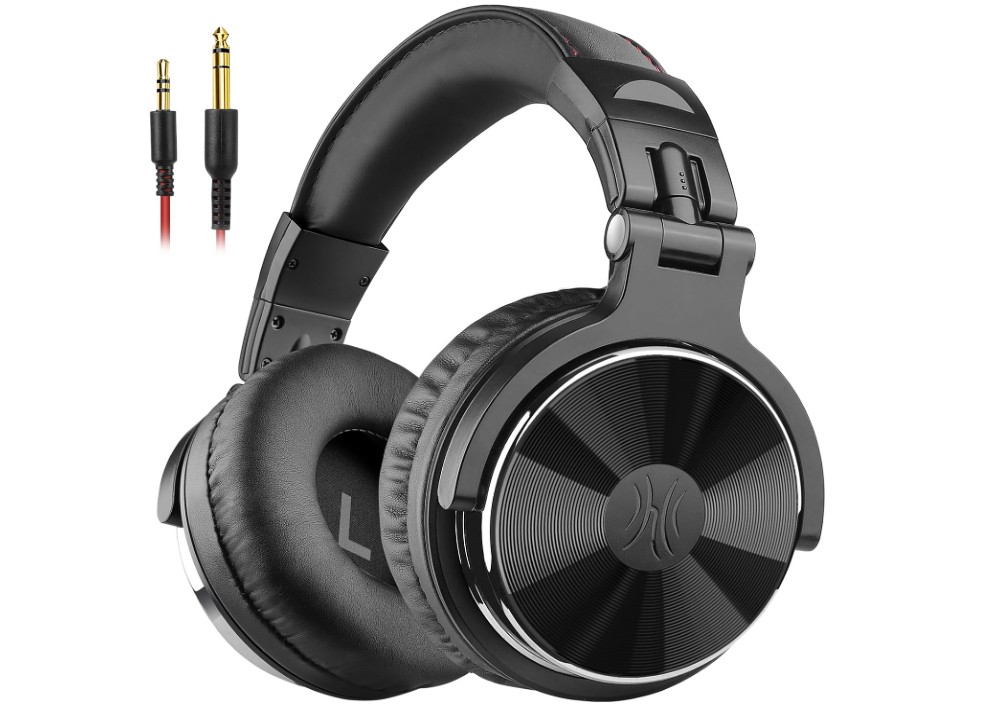
OneOdio Wired Over Ear Headphone
OneOdio Wired Over Ear Headphone
The OneOdio Wired Over-Ear Headphones are a compelling proposition for budget-minded creators, DJs, podcasters, and home studio hobbyists. Packing 50 mm neodymium drivers, a detachable coiled cable, and a gold-plated ¼″ adapter, they promise “studio-monitor” clarity without the hefty price tag. Here’s how they stack up in real-world use:
Design & Build
Visually, the OneOdio M50X (or similar variants) follow a classic DJ/monitor aesthetic: matte-black ear cups, a telescoping metal headband, and stiff plastic yokes. The tough, faux-leather pads are generously filled, and the headband cushion strikes a reasonable balance between firmness and plushness. Joints swivel a full 90°—ideal for one-ear cueing—and the entire assembly folds flat for storage. While the plastic components feel a touch lightweight compared to pro-grade rivals, reinforced hinges and a secure snap-in detachable cable system instill confidence that they’ll survive daily rigors.
Comfort & Isolation
Thanks to deep, circumaural pads, the headphones envelop most ear sizes without excessive clamping force. In extended sessions (2–3 hours), you may notice mild pressure on the temporal bone—but it’s never painful. Passive noise isolation is impressive: the thick pads block much of the room’s ambient chatter, though they won’t rival sealed, noise-canceling cans. For vocal recording or mixing in moderately noisy environments, they strike a solid compromise between comfort and isolation.
Sound Quality
At the heart of the M50X’s appeal is its 50 mm dynamic driver architecture. Out of the box, the presentation is “V-shaped” with boosted bass and treble: thumping kick-drums and synths feel punchy, vocals sit forward, and cymbals shimmer with crispness. Low-end extension reaches deep sub-bass, though audiophiles may detect slight bloom around 60–80 Hz. Mids are clear but can seem recessed when the bass is at full throttle. The treble is detailed, lending sparkle to hi-hats and acoustic guitars—but push them too loudly and harshness may emerge above 10 kHz. The soundstage is surprisingly wide for closed-backs, offering decent instrument separation. For podcast monitoring, electronic music, and casual mixing, they deliver more than respectable fidelity at this price.
Connectivity & Versatility
The package includes two detachable cables: a 1.2 m straight cable with inline mic/remote for smartphones, and a 3 m coiled cable for studio gear. Swapping cables is swift, thanks to locking 3.5 mm jacks. A ¼″ (6.3 mm) screw-on adapter lets you plug into audio interfaces, mixers, and amps. Impedance is rated around 32 Ω, making them easy to drive from laptops, desktops, and portable recorders without an extra headphone amp.
Verdict
For under $50, OneOdio’s wired over-ear headphones deliver an exceptional blend of comfort, functionality, and sound quality. They won’t replace high-end studio monitors, but for budding DJs, podcasters, and gamers, they’re a go-to workhorse—punchy, reliable, and budget-friendly.
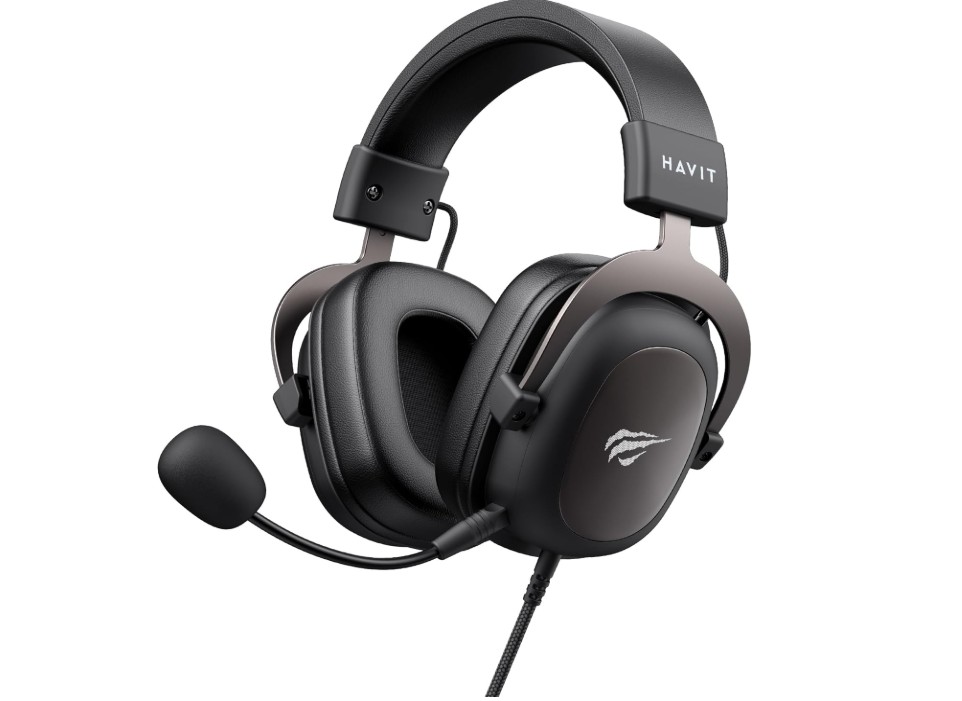
havit H2002d Wired Gaming Headsets
havit H2002d Wired Gaming Headsets
The Havit H2002D gaming headset delivers a surprisingly robust feature set and solid build quality for its budget-friendly price. Tailored for PS4, PS5, PC, and mobile gaming, it packs 50 mm drivers, a durable aluminum frame, and an adjustable omnidirectional microphone into a lightweight, comfortable design. Here’s an in-depth look at how it performs across the board.
Design & Build Quality
On first impression, the H2002D’s matte-black ear cups and headband look understated but are reinforced with a slim aluminum band that runs through the cushions—adding rigidity without significant weight. The plastic housing feels thick and durable, and joints are snug, showing no play when you swivel or adjust the cups. The ear pads and headband cushion are wrapped in synthetic leather over memory-foam padding; they compress just enough to feel plush yet spring back quickly. A braided, 2.2 m cable terminates in dual 3.5 mm plugs (for PC) plus a 4-pole 3.5 mm adapter for consoles and mobiles, making the headset broadly compatible.
Comfort & Fit
Clamping force is moderate: firm enough to keep the cups sealed around your ears without discomfort. The ear cups themselves are large and deep, accommodating most ear shapes without pressure on the pinnae. In 2–3 hour sessions, you’ll appreciate the breathable memory foam, though the synthetic leather can trap heat in very warm environments. The adjustable headband offers ample range for both small and large heads, and weight—at roughly 320 g—is light enough to feel almost weightless during long raids or competitive matches.
Microphone Performance
The detachable boom mic is omnidirectional and picks up voices with clarity, reducing background noise effectively. In tests, teammates reported clear, natural voice timbre with minimal hiss or distortion. The mic’s flexible arm lets you position it just off your lips; when you’re done chatting, simply swing it up to mute by retracting it slightly into the ear cup. While it won’t match a dedicated standalone mic for studio streaming, it’s more than adequate for in-game communication, Discord calls, and casual streaming.
Audio Quality & Surround Sound
Driven by large 50 mm neodymium drivers, the H2002D emphasizes a V-shaped sound signature: punchy bass, clear mids, and bright treble. Explosions and engine roars in action titles feel weighty and immersive, while footsteps and ambient cues in shooters cut through crisply—helpful for competitive play. Dialogue and music in story-driven games come through with good detail, though mids can occasionally feel recessed when bass is cranked. Havit’s “virtual surround sound” mode, toggled via an inline switch on the cable, broadens the perceived soundstage, making it easier to locate directional audio cues. It’s not true hardware-driven surround, but it adds a convincing sense of space for 7.1-enabled titles on PC.
Verdict
The Havit H2002D headset punches above its weight, offering a blend of comfort, durability, and engaging audio for under $40. While it’s not a perfect studio rig—mids can be a touch veiled and the leatherette pads trap heat—it excels in gaming scenarios, especially for FPS and action titles where impactful bass and directional cues matter. For PS4, PS5, PC, and mobile gamers on a budget, it’s a highly recommendable option that won’t break the bank.
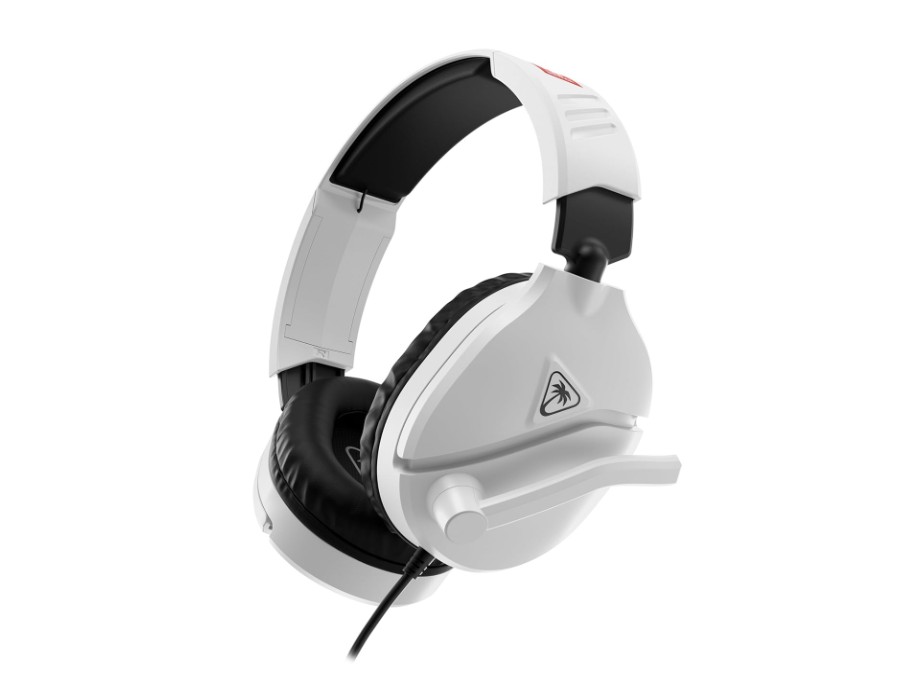
Turtle Beach Recon 70 Wired Gaming Headset
Turtle Beach Recon 70 Wired Gaming Headset
The Turtle Beach Recon 70 Wired Gaming Headset is a well-balanced, budget-friendly audio solution built specifically with console gamers in mind—especially those on the Nintendo Switch family of devices, including the Switch OLED and even future-ready for the Nintendo Switch 2. Known for its lightweight build, flip-to-mute microphone, and cross-platform compatibility, the Recon 70 aims to offer solid audio performance without draining your wallet. But how does it stack up in terms of comfort, sound, and durability? Let’s break it down.
Design & Build Quality
The Recon 70 sports a clean, modern design, available in color accents that match Nintendo’s console branding. The plastic frame keeps weight impressively low—just around 250 grams—which makes it perfect for younger gamers or extended handheld gaming sessions. Despite the all-plastic construction, it feels reasonably sturdy, and the flexible headband accommodates a range of head sizes. The ear cups swivel slightly for a better fit, and the synthetic leather-wrapped foam ear cushions are soft enough for a few hours of gaming, though they may cause heat buildup over time. For a sub-$40 headset, the build quality is above average.
Comfort & Fit
Thanks to its ultra-lightweight design and modest clamping force, the Recon 70 is comfortable to wear for long periods, especially for casual and younger users. The over-ear design helps create a decent seal without too much pressure. While the ear cushions are not memory foam, they’re adequately padded and soft. However, gamers with larger ears might find the ear cups a bit shallow. The headband is adjustable and stays snug without constantly needing readjustment.
Microphone Quality
The standout feature of the Recon 70’s mic is its flip-to-mute function. It’s intuitive—flip the mic up and you’re muted instantly, which is great during multiplayer sessions or quick chats. The mic is non-detachable but flexible and positioned well to pick up voice clearly. In use, it provides decent clarity for in-game communication and chat apps like Discord. It does tend to pick up some background noise, but for casual and console use, the voice transmission is crisp and dependable.
Audio Performance
Equipped with 40 mm drivers, the Recon 70 delivers solid, well-rounded sound for its price. The bass response is strong but not overpowering, making explosions, footsteps, and in-game effects immersive. The mids are clear enough for voice lines and dialogue, and highs are decently crisp, although slightly rolled off at the top end. While it doesn’t offer surround sound or spatial audio features, the stereo imaging is good enough for casual FPS play and adventure games. The soundstage is relatively narrow compared to high-end headsets, but it works well for Switch gaming. Plug-and-play with a 3.5 mm jack means no extra software or setup is needed—just connect and go.
Verdict
The Turtle Beach Recon 70 is a reliable, entry-level wired headset that punches above its weight, especially for Nintendo Switch gamers. With its lightweight frame, flip-to-mute mic, and decent audio performance, it delivers great value at a very affordable price point. While it lacks some premium features like surround sound or deep customization, it excels in plug-and-play simplicity and daily comfort. For casual gamers, younger players, or those looking for a budget headset that just works, the Recon 70 is an easy recommendation.
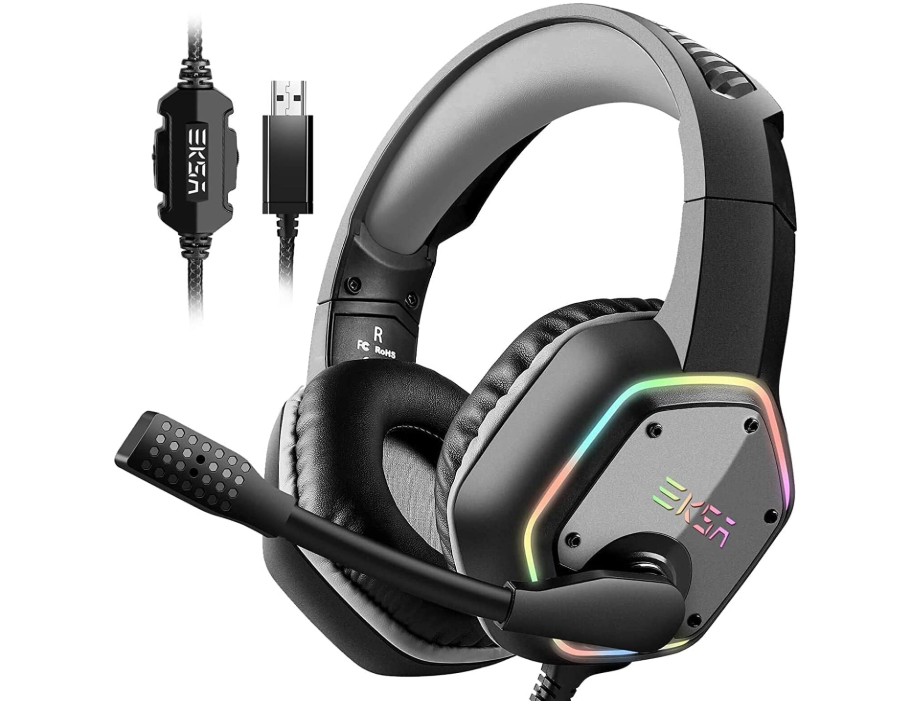
EKSA E1000 USB Gaming Headset
EKSA E1000 USB Gaming Headset
The EKSA E1000 USB Gaming Headset packs a surprising amount of features into an entry-level package: from a noise-cancelling boom mic to virtual 7.1 surround sound, RGB illumination, and a USB plug-and-play connection. Designed for PC and consoles (PS4, PS5) as well as general computer use—think call-centers or online meetings—it aims to be a one-stop headphone solution. Here’s how it holds up in daily use.
Design & Build Quality
Out of the box, the E1000 feels sturdier than its sub-$40 price suggests. The headband frame is metal-reinforced beneath its matte-black plastic exterior, and the adjustable sliders extend smoothly without wobble. The ear cups are large, oval-shaped, and covered in soft protein-leather padding that comfortably envelops most ears. A translucent ring around each cup houses addressable RGB LEDs, which run through preset breathing and color-cycle modes via an inline controller. The braided USB cable feels durable, though at 2.2 m it can feel slightly unwieldy on cramped desks. Overall, the build inspires confidence for regular gaming sessions and daily office use alike.
Comfort & Fit
With approximately 280 g of weight and a gentle clamping force, the E1000 strikes a nice balance between secure fit and long-wear comfort. The plush memory-foam padding on both headband and cups mitigates pressure points, even during four-hour marathon streams or work calls. The ear cups swivel only minimally (about 15°), so you won’t get full flat-fold portability, but they do conform well to head shape. In warmer environments, the faux-leather can trap heat, so plan on periodic breaks or use a desk fan for extended comfort.
Microphone & Noise Cancellation
The detachable unidirectional boom mic features EKSA’s “noise-cancelling” design, which focuses pickup on your voice and filters out ambient room noise. In practice, it offers clear, intelligible audio on Discord or Zoom, with only slight hiss when you push gain high. A flexible arm lets you position the capsule close to your mouth, and the inline mute switch is immediately accessible. While it won’t rival a dedicated XLR mic, it’s more than competent for in-game chat, business calls, and podcasting drafts.
Audio Performance & 7.1 Surround
On the audio side, the E1000 uses 50 mm drivers tuned for a moderately V-shaped signature: punchy bass, forward mids, and crisp highs. Explosions and engine rumbles in FPS or racing titles benefit from good low-end extension, while dialogue and music remain clear. Stereo mode provides decent imaging, but the real draw is the virtual 7.1 surround feature, activated via the Windows driver. In supported titles, positional cues (footsteps, off-screen gunfire) become noticeably more precise, giving a competitive edge in shooters. However, like most USB virtual surround solutions, it can feel slightly “processed” or artificial compared to true multichannel setups. If ultimate accuracy isn’t critical, it’s an engaging enhancement.
Verdict
For under $40, the EKSA E1000 delivers an impressive array of features: sturdy construction, comfortable fit, clear communication, and virtual 7.1 surround—all wrapped in customizable RGB flair. It shines for gamers who want positional audio and mic quality without investing in separate gear, and it doubles as a capable headset for work calls or casual music listening. If you prize a budget-friendly USB solution with a bit of style, the E1000 is a hard value to beat—just be mindful of heat-trapping pads and the somewhat “digital” surround processing.
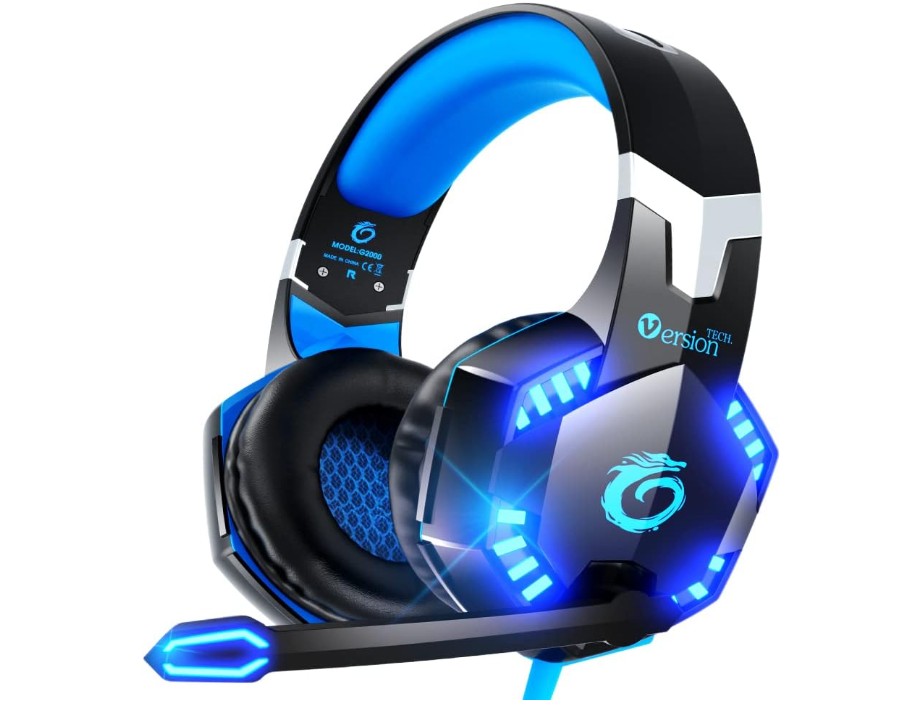
VersionTECH. G2000 Gaming Headset
VersionTECH. G2000 Gaming Headset
The VersionTECH G2000 Gaming Headset delivers a budget-friendly package aimed at console and PC players alike, with RGB lighting, bass-enhanced drivers, and a noise-cancelling microphone. Here’s how it fares across design, comfort, audio, and usability in real-world gaming sessions.
Design & Build Quality
Visually, the G2000 follows the modern “gamer” aesthetic: angular ear cups, glowing LED accents, and a matte-black finish. The plastic frame incorporates metal-reinforced sliders for durability, and the headband padding is stitched to resist peeling. Cables are braided for tangle resistance and end in a single 3.5 mm plug plus an LED-powered USB connector (required to light up the headset). Though the chassis is predominantly plastic, joints feel snug with minimal wobble when you adjust the cups. Overall, it strikes a solid balance between eye-catching styling and sturdy construction for its under-$40 price point.
Comfort & Fit
With roughly 310 g of weight and a moderate clamping force, the G2000 stays put without pinching too tightly. The over-ear pads use a mix of breathable mesh and protein-leather, offering good cushioning for sessions up to three hours. The headband cushion distributes weight evenly, though very wide heads might feel slight pressure at the temples. The ear cups swivel about 15° to conform to your head shape, and the adjustable headband provides plenty of height range for both smaller and larger craniums.
Microphone Performance
The flexible boom microphone features basic noise reduction, focusing on your voice while minimizing ambient room noise. In practice, teammates on Discord and in-game chat reported clear, consistent pickup with only a hint of background hiss at higher gain levels. The mic mutes via an inline switch—handy for quick silencing when you need to talk to someone in real life. While it won’t compete with standalone desktop mics, it’s more than sufficient for online multiplayer communication and casual streaming.
Audio Quality & Bass Surround
Using 50 mm neodymium drivers, the G2000 emphasizes a bass-heavy, V-shaped sound signature. Explosions, engine roars, and in-game effects pack a satisfying punch, giving a visceral feel in action-packed titles. Midrange clarity is serviceable but can feel a touch recessed when the bass is dialed up. Highs are clear enough for dialogue and environmental cues, though they lack the sparkle of pricier headsets. VersionTECH’s “bass surround” mode—activated via a switch on the ear cup—attempts a virtual surround effect by layering bass modulation; it widens the perceived soundstage in shooters but introduces slight processing artifacts. For most console and casual PC gamers, the immersive low-end and simple surround boost however offer a fun audio experience.
Verdict
The VersionTECH G2000 stands out as a compelling option for budget-conscious gamers seeking flashy aesthetics and bass-driven audio. It won’t satisfy audiophiles chasing neutral accuracy or replace a full-fledged surround-sound setup, but its sturdy build, comfortable fit, and punchy low end make it a solid pick for PS5, PS4, Xbox, Switch, and PC play. If you want an affordable headset that looks the part and delivers impactful game audio, the G2000 covers the essentials with style.
Buying Guide of Budget Headphones Under $50
In a landscape crowded with choices, finding a reliable, high-quality wired headphone under $50 can feel daunting. Yet today’s budget segment offers remarkable options that deliver solid audio performance, durable construction, and useful features—without breaking the bank. This 1,000-word guide walks you through every consideration, from sound signature and fit to connectivity and special features, so you can zero in on the perfect wired headset under $50 for your needs.
Decoding Sound Signatures
Every headset has an inherent tonal balance, commonly referred to as its “sound signature.” In the budget tier, you’ll most often see:
- V-Shaped (Bass-Forward)
Boom-heavy lows and sparkling highs for an exciting, “fun” sound. Ideal for action games, EDM, and movies—but vocals/instruments in the mids can sometimes get masked. - Balanced (Neutral)
Even-keel bass, mids, and treble for a true-to-source presentation. Rarer under $50 but prized by budding audiophiles and home-studio users. - Warm
Emphasized low frequencies with slightly rolled-off highs for a mellow, easy-listening vibe—great for podcasts, audiobooks, and long listening sessions.
Tip: Look for descriptors like “studio monitor,” “flat,” or “reference” (neutral), and “gaming” or “bass” (V-shaped).
Build Quality & Durability
Even budget headsets can be rugged if you know what to look for:
- Materials & Reinforcements
- Plastic Frames: Most common; choose ones with metal-reinforced sliders or yokes.
- Metal Components: Sometimes found in headbands or hinge points; add longevity.
- Cables
- Braided vs. PVC: Braided cables resist tangles and fraying; PVC cables are cheaper but more prone to wear.
- Detachable vs. Fixed: Detachable cables future-proof your headset—replace the cord without replacing the entire unit.
- Connectors
- Gold-Plated 3.5 mm Jack: Resists corrosion, ensures snug fit.
- ¼ in (6.3 mm) Adapter: Handy for home-audio gear and professional interfaces.
Comfort & Fit
A great sound signature means little if the headset feels like a vice:
- Form Factor
- Over-Ear (Circumaural): Cups fully enclose the ear, offering better isolation and comfort for extended use.
- On-Ear (Supra-aural): Cups sit on the ear, yielding a lighter, more portable design but potentially more ear pressure.
- In-Ear (IEM): Ultra-compact and portable; strong passive isolation—but tip choice is critical for comfort and seal.
- Padding Materials
- Memory Foam: Conforms to your head and ears, reducing pressure points.
- Leatherette vs. Fabric: Leatherette blocks noise and feels plush but can trap heat; fabric breathes better but leaks more ambient noise.
- Clamping Force
- Too Loose: Poor seal and low bass response.
- Too Tight: Headaches and fatigue.
Aim for moderate tension that balances seal with comfort.
Connectivity & Controls
Modern wired headsets often include extra controls:
- In-Line Remote & Mic
Handy for calls and media playback—volume, play/pause, and mic mute. Check whether it uses CTIA (iPhone) or OMTP (older Android) wiring if you need full compatibility. - Flip-to-Mute Boom Mic
Common in gaming headsets: flip the mic up to mute instantly—no buttons required. - Single vs. Dual Plugs
- Dual 3.5 mm (Audio + Mic): Standard for PCs—requires separate audio jacks.
- Single 4-pole 3.5 mm: One plug for both audio and mic—preferred by consoles, laptops, and phones.
Key Technical Specs
- Driver Size (mm)
- Larger drivers (≥40 mm) often yield deeper bass and a wider soundstage in over-ear designs.
- Impedance (Ω)
- Low (16–32 Ω): Easily driven by smartphones, tablets, and laptops without an amp.
- High (≥50 Ω): May require a headphone amplifier for optimal volume and clarity.
- Sensitivity (dB/mW)
- Indicates loudness at a given power level. Headsets above 100 dB/mW can get very loud on mobile devices; watch for distortion at max volume.
Special Features & Extras
- Virtual Surround Sound
Software-or hardware-driven 7.1 modes can enhance spatial cues in games. Be aware that processing artifacts (a slightly “synthetic” feel) are common. - Passive Noise Isolation vs. Active Noise Cancelling (ANC)
- Passive Isolation: Achieved via snug seals—standard under $50.
- ANC: Rare under $50; expect only basic blocking if included.
- Foldable or Collapsible Designs
Heads-up for travelers: fold-flat hinges and included carrying pouches make packing easier.
Frequently Asked Questions
Q: Are wired headsets always better than wireless under $50?
A: Generally, wired avoids Bluetooth limitations—no latency, no battery concerns, and simpler pairing. But modern wireless can sometimes match sound quality at higher price points.
Q: How do I prevent cable tangles?
A: Choose braided or flat cables. Use cable ties or a small organiser, and always store headphones neatly (folded or with detachable cables).
Q: Can I use a gaming headset for music?
A: Absolutely—just be aware that many gaming headsets emphasize bass and treble (V-shape). If neutral reproduction matters, look for “studio” or “reference” models.
Making the Final Decision
- Define Your Priority: Sound style (bass vs. neutral), mic quality, or portability?
- Check Compatibility: Single vs. dual plugs, CTIA vs. OMTP for calls, USB vs. analog.
- Examine Build & Comfort: Look at materials, padding, and weight.
- Read User Reviews: Real-world feedback uncovers comfort quirks, cable durability, and sound nuances.
By carefully weighing these factors, you can confidently select a wired headset under $50 that meets your needs—whether you’re diving into competitive gaming, enjoying your favorite music on the go, or recording podcasts and calls at home. In today’s budget market, exceptional audio is no longer a luxury; it’s within everyone’s reach.
A passionate tech enthusiast with a deep interest in the latest innovations, gadgets, and emerging technologies. Always eager to explore cutting-edge hardware and software, I enjoy sharing insights, reviews, and recommendations to help others make informed decisions in the ever-evolving tech world. With a curious mindset and hands-on approach, I stay up-to-date with industry trends, from PCs and gaming to mobile devices and AI-driven tools.






